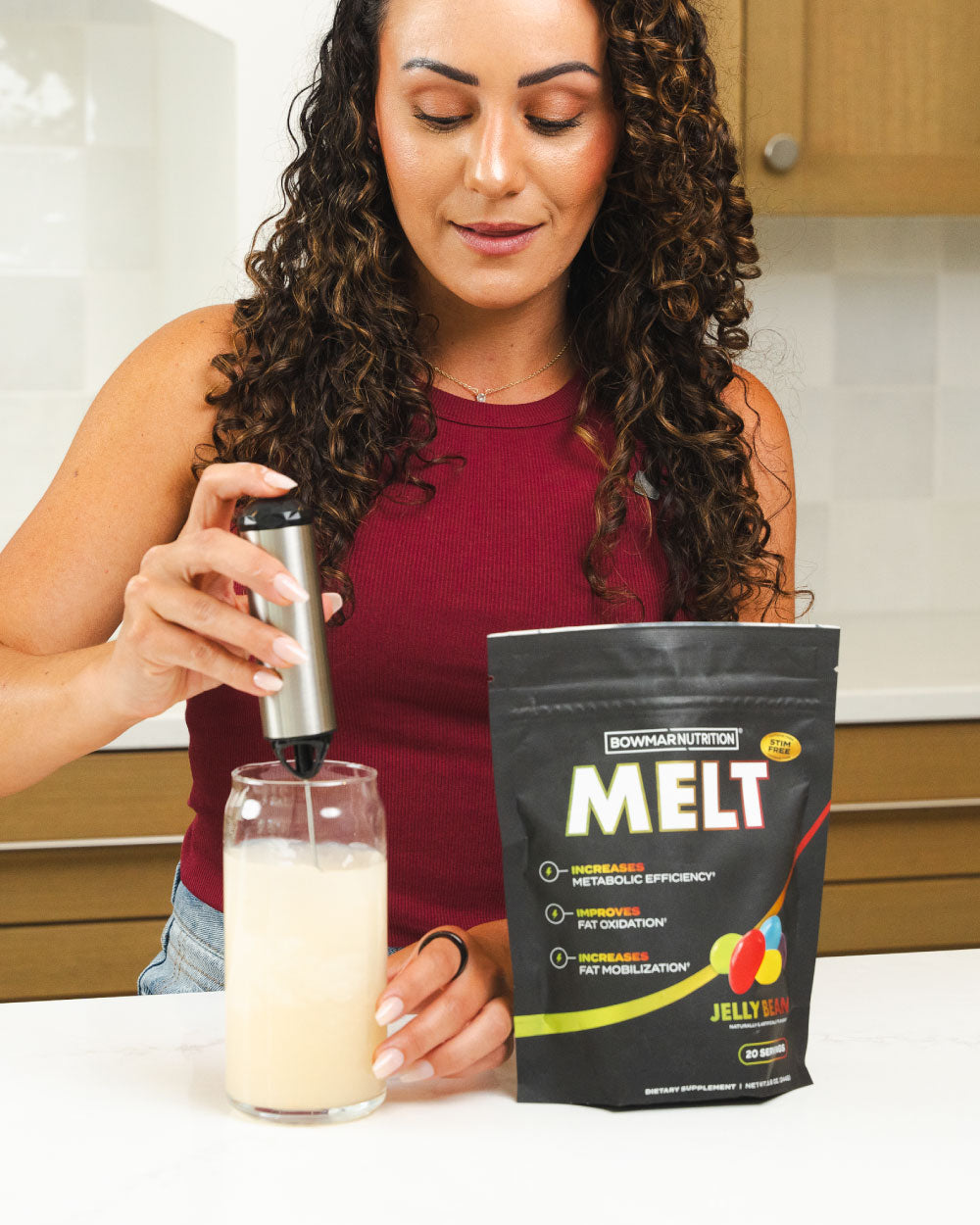Paired with a calorie deficit, this product actually WORKS with fat loss and body recomposition. I wanted to break down the different goals of this product, which ingredients facilitate those goals, and how the formula works so well! I also want to give everyone an overview on the different types of fat, how it is stored, and information on our metabolism.
Let’s Chat Fat
Before we dive into the product, I want to first quickly discuss fat within the body. Losing fat is a complex process within the body. The simple explanation that majority of us understand, eat less than you burn (above your BMR), and your fat cells will shrink (they never go away). The complex part… there are three different types of fat cells in the body: white, brown, and beige and they are stored in three ways: essential, subcutaneous, or visceral fat.
Essential Fat
This fat is essential to a healthy body. It plays a major role in vitamin absorption, temperature regulation, and hormone regulation (including the hormones that control fertility). This fat is found in your: brain, bone marrow, nerves, and membranes that protect your organs. According to the ACE (American Council on Exercise), women need at least 10% of their body composition to come from essential fat to be in a good health and men require at least 2%.
Subcutaneous Fat
Referred to the fat stored under your skin, it is compromised of a combination of brown, beige, and white fat cells. The MAJORITY of our body fat is subcutaneous. It’s the fat you can squeeze or pinch. When you are measuring body fat with calipers, this is what you are measuring to estimate your total overall body fat percentage. The “healthy” level varies from person to person but too much causes immense stress on the body which can lead to a number of issues, including obesity and imbalanced hormones.
Visceral Fat
Often referred to as “belly fat”, it is the white fat that’s stored in your abdomen and surrounds all of your major organs (intestines, heart, liver, etc.). Too high visceral fat can increase risk of diabetes, heart disease, cancers, etc.
White, Brown, Beige Fat
White fat: the job of white fat is to store energy and produce hormones secreted into the blood stream. As we know from above, fat cells do not just go away. They can only shrink or grow. Small fat cells produce a hormone called adiponectin which makes the liver and muscles sensitive to the hormone insulin (making that person less susceptible to diabetes and heart disease). When you become overweight, the production of adiponectin slows or shuts off, increasing the risk.
Brown fat: In a recent study, scientists have found lean people tend to have more brown fat than overweight people. It has also been proven to burn calories when stimulated. When activated, brown fat burns white fat. Brown fat contains more mitochondria than white fat does, and these “engines” burn calories to produce heat. In other recent studies, it appears to be able to use regular fat as fuel. Additionally, exercise may stimulate hormones that activate brown fat. We have a very small percentage of brown fat in our bodies.
Beige fat: scattered throughout ordinary fat tissue. It behaves like weight fat cells until they are activated through a process called browning. After they are browned, they start to behave like brown fat and burn other white fat for energy. This study has an entire list of how to “brown” fat but the top three ways: socialization, exercise, and cold exposure. It also may help improve insulin sensitivity. Poor insulin sensitivity can cause weight gain. Resistance to insulin causes the body to produce more insulin, which leads to increased hunger, higher blood pressure, and weight gain.
Metabolism 101
A lot of people misunderstand what the word “metabolism” means. It isn’t just one process in your body, it’s within every cell within your body. It refers to a series of chemical processes in each cell that turn the calorie you eat into fuel to keep you alive. Your BMR (basal metabolic rate) measures how many calories you burn while at rest. The body’s major organs – brain, liver, kidneys, and heart – account for about half of the energy burned at rest. The other half is compromised of fat, the digestive system, and the body’s muscle mass.
Most (up to 80%) of the energy (calories) you burn each day is from your resting metabolism (BMR). Adding in exercise will increase the body’s calories burned per day as will increasing muscle mass lead to an increase your BMR. Metabolism, daily cell function, and endocrine system can all be negatively affected in overweight and obese individuals. Full study to be found here.
So, how does this translate to MELT? Let’s break down the ingredients and how everything works together!
Mobilizing Fat
What does it mean to mobilize fat? Fat mobilization is an increased breakdown of fat (triglycerides) with the release of fatty acids into the bloodstream.The physiological process of fat loss occurs when fats are liberated from adipocytes (fat cell) into circulation to supply the needed energy. If you have a browned fat cell, the brown fat burns without shivering. This process is called thermogenesis. During this process, the brown fat burns calories as well.
Full study can be found here.
In MELT, we have several ingredients that will improve the body’s ability to mobilize fat:
- L-Tyrosine: an amino acid that is a precursor for epinephrine, norepinephrine, and dopamine. This can reduce stress and cortisol (which elevated levels have been proven to cause overeating and weight gain)
- Caffeine: one of the few substances known to help mobilize fats from your fat tissues and can help suppress appetite
- Capsimax: non-stimulant fat burner that can assist with lipolysis (breakdown of fat stored as triglycerides in fat tissue into free fatty acids to be used as a fuel source for contracting muscles
- Green Tea Leaf Extract- contains various polyphenols that exude a positive metabolic effect on the body. In a double blind, placebo controlled, study shows a 24 hour energy expenditure increase by 4.6%. Full study can be found here
- Theobromine: structurally similar to caffeine and derived from cocoa, it facilities browning (as described above). Full study can be found here.
- Chromium: sensitizing insulin which makes your cells more receptive to absorb glucose, preventing an excess from floating around in your blood steam. Too much glucose in the blood causes fat build up in artery walls. Too much will also send a signal to the brain for more glucose (sugar) to correct the balance
- Bitter orange: increases metabolism and energy expenditure. Full study can be found here
Oxidizing Fat
Fat is stored in adipose tissue as triglycerides. These are released into the bloodstream by the enzyme Hormone-Sensitive Lipase, where they can then be oxidized (burned / used) for energy. This is a process called lipolysis (as mentioned above). Fat oxidation is broken into three phases: lipolysis, mobilizing (above), and oxidation.
The second phase of fat burning comes in the form of fatty acid mobilization (via the description above). Once the triglycerides are separated from the glycerol molecule and released from the fat cell, the fatty acids enter the blood stream and are shuttled to the target cell requiring entry (entering muscles to be “burned”). Oxidation begins at the arrival to the target cell.
Burning Fat for Fuel
Oxidation begins as the fatty acids enter the cell and store in the cytoplasm. In order for them to be burned for energy, they must enter the mitochondria (aka the engine). These are shuttled into the mitochondria via carnitine. Once converted into ATP, the energy is used to fuel your activity (walking, digestion, weight lifting, etc.).
If you don’t have an immediate need for the energy- what then? If you are fasting, high amounts of fatty acid will be converted into ketones for brain and muscle energy.
How to Increase Fat Oxidation
Reduce Calories: when you reduce overall caloric intake, your body has to make up for the lack of food you’re giving it by using energy from stored fat.
Insulin Regulation: simply sugars and carbs cause insulin levels to rise which effectively shuts off the fat burning process. Carbs aren’t bad, but you want to ensure you’re ingesting complex carbs or protein to create lower insulin spikes and promote fat burning.
ExerciseL increasing your calorie output through training can tip the energy balance in the favor of fat loss. Additionally, building muscle to increase BMR (as stated above), is a great way to increase calorie demand on a daily basis.
How does MELT play into all of this? Let’s dive into the fat oxidation formula of the product:
- Acetyl-L-Carnitine: an amino acid derivative that helps the mitochondria to burn fat to produce more energy. Full study found here
- L-Carnitine L-Tartrate: aids in maintaining healthy glucose levels and weight in already healthy individuals when taken in conjunction with a healthy diet & exercise. Full study found here
- L-Carnitine: decreases the amount of fat stored, also proven to reduce visceral (belly) fat. Full study found here
- Rauwolfia: plant based molecule similar to yohombine but without the anxiety side effects, can help reduce appetite and blocking alpha-adrenergic receptors and enabling fat burning to continue functioning seamlessly
- KSM 66 Ashwagandha: an adaptogen that helps decrease stress (cortisol) and increase testosterone in those who are active and weight train. Full studies found here and here
Metabolic Health
Now that we know about the three stages of fat burning (lipolysis, fat mobilization, and fat oxidation), let’s discuss metabolic health. During fat loss, it is not uncommon for your metabolism to slow, especially if you are crash dieting or calories are too low (which is obviously NOT recommended). If you are not eating enough protein, your body can also start to cannibalize its own muscle, again NOT recommended. If you are confused on how much protein you need per day, I recommend checking out this blog. Even if you are doing everything right, it is still imperative to ensure you are fueling your body with proper vitamins and nutrients for it to function as best it can. If you are operating at a 4 out of 10, your fat loss will operate at the same level too. This is why we wanted to include additional vitamins and ingredients to ensure you are operating at a 10 at all times, not just for fat loss reasons, but for overall health reasons.
- Taurine: helps inhibits fat buildup inside of white fat cells; tends to be depleted while taking fat burners
- MagnesiumL one of the most important electrolytes and tends to be depleted during dieting and the use of fat burners
- Hesperidin: regulates glucose and lipid metabolism; regulate carbohydrate metabolism. There has been a recent study conducted of cyclists taking hesperidin that saw significant fat loss as well as an increase in muscle mass. Placebo group saw no change for both fat or muscle. Study can be found here
- L-Tryptophan: serotonin helps with satiety (feeling full)
- Vitamin C: antioxidant
- Potassium: electrolyte that tends to be depleted while on fat burners
- Vitamin E: antioxidant
- Zinc: antioxidant and involved with many daily functions
- Vitamin D: fat soluble vitamins responsible for various bodily functions
- Selenium: deficiency can reduce thyroid function



Share:
Is Glutamine Right for You?
The Health Benefits of Probiotics